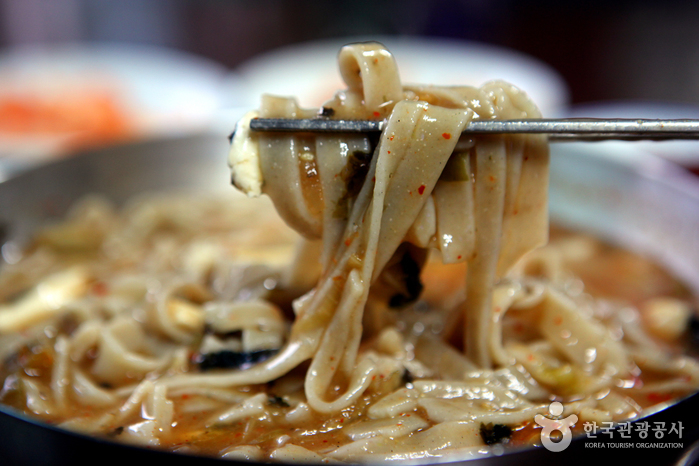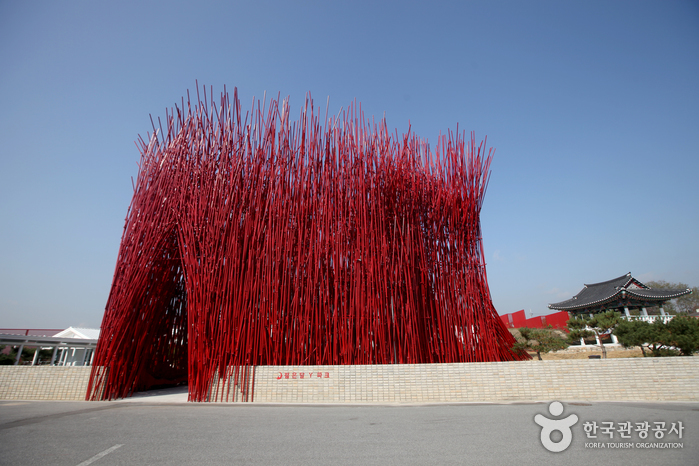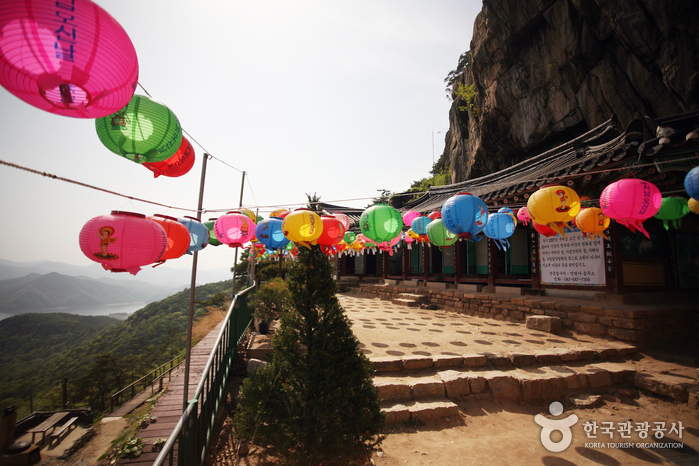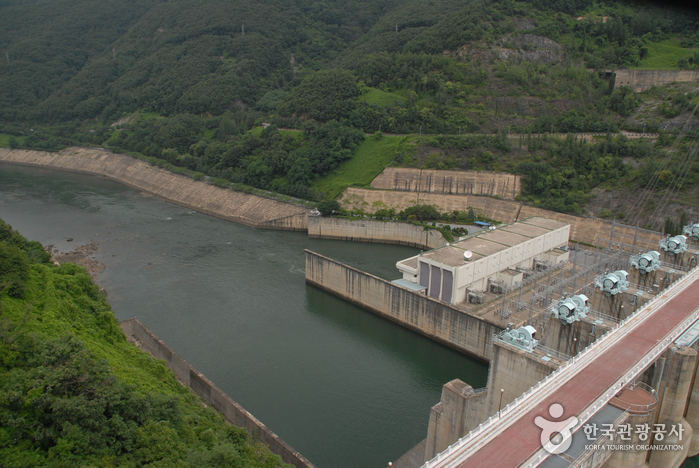Cheongpung Cable Car (청풍호반케이블카)
18.1Km 2024-07-31
166 Munhwajae-gil, Jecheon-si, Chungcheongbuk-do
Cheongpung Cable Car takes passengers back and forth between Multae-ri in Cheongpung-myeon and Bibongsan Mountain along a 2.3-kilometer ropeway. There are a total of 43 cabins that accommodate up to 10 passengers per car, with ten cabins featuring transparent flooring to offer a thrilling bird's-eye-view of Cheongpung-myeon. The cable car can reach a maximum speed of 5 meters per second and takes around 10 minutes from the departure point to Bibongsan Mountain peak. Bibongsan Mountain sits at the center of Cheongpungho Lake and has an elevation of 531 meters. The sight from top offers a feeling as if one is looking down at an archipelago. The cable car allows children and the elderly to enjoy the sight without the hassle of hiking up to the summit.
Neutinamu Hoetjip (느티나무횟집)
18.5Km 2024-03-25
4 Baesiron-ro, Cheongpung-myeon, Jecheon-si, Chungcheongbuk-do
+82-43-647-0089
Neutinamu Hoetjip is a distinguished Korean restaurant situated within Cheongpungho Bibimbap Town. Its standout dish is songeo bibimhoe (spicy raw trout salad with vegetables). The salad highlights the freshness of sliced raw trout, enriched with a mix of powdered soybean, perilla leaves, sesame oil, and cucumber for a unique blend of flavors and textures. Beyond this signature dish, Neutinamu Hoetjip offers an array of local specialties featuring freshwater fish. Their sutbul maneul tteokgalbi (charcoal-grilled garlic and galbi patties) and ssogari maeuntang (spicy mandarin fish stew) are also popular choices among patrons.
JOGYUNDANG [Korea Quality] / 조견당[한국관광 품질인증]
19.0Km 2024-07-24
27, Gogaok-gil, Jucheon-myeon, Yeongwol-gun, Gangwon-do
+82-33-372-7229
Located in Jucheon-myeon, Yeongwol-gun, Gangwon Province, Jogyeondang (House of Kim Jong-gil) is a traditional “hanok” stay. The nine rooms of the house follow the traditional “hanok” format. Anchae, the inner building with nearly 200 years of history, is dignified and elegant as befitting of its age. The majestic rafters of the building were built from 800-year-old trees, and the “daecheongmaru” raised floor has a sheen from years of care. Sarangchae and Byeolchae, restored in 2007 and 2009, respectively, make up for their relative lack of historical weight with freshness and convenience. The Inner Sarangchae faces the Anchae and the courtyard, while the Outer Sarangchae connects to a space with floor tables, cushions, and bookcases for drinking tea or reading. Guests staying in the three rooms in the Outer Sarangchae and the Anchae Geonneonbang rooms must use a shared bathroom, while other rooms come with private bathrooms. The uniqueness of Jogyeondang lies in its extensive cultural program, which ranges from tea ceremonies to soirees in the historical building. The complex’s manager has many stories to tell about the history of the house and its construction. Breakfast is also available upon reservation and payment, and English and Chinese services are provided for international visitors.
Jecheon Sikdang (제천식당)
19.1Km 2024-02-16
3 Docheon-gil, Jucheon-myeon, Yeongwol-gun, Gangwon-do
This restaurant in Yeongwol specializes in buckwheat noodles, handling every step of the noodle-making process in-house. These freshly made noodles are the key ingredient in the restaurant's signature dish, kkolttu guksu (Gangwon buckwheat noodle soup), a traditional folk dish of Gangwon-do. The dish is known for its mild and savory flavors, making it a great option for those who prefer to avoid spicy food. In addition to kkolttu guksu, the restaurant also offers makguksu (buckwheat noodles) and naengmyeon (cold buckwheat noodles).
Chungjuho Lake (충주호)
19.3Km 2024-03-08
Jodong-ri, Dongnyang-myeon, Chungju-si, Chungcheongbuk-do
+82-43-850-5114
Chungjuho Lake is the nation’s largest lake, and was formed after the construction of Chungju Dam. When constructing the dam, an area of approximately 66.48 ㎢ was submerged throughout three regions in Chungju, Danyang and Jecheon. Even though nearly 50,000 people lost their hometown, the lake became a famous regional tourist spot, along with Woraksan National Park, Songgye Valley, Cheongpung Culture Center, Eight Sceneries of Danyang, Gosu Cave, Guinsa Temple, Suanbo Hot Springs, Nodong Cave and other spots.
Tourists can enjoy the scenic area on five ferry docks from Chungjunaru, main ferry dock of Chungju Dam, Cheongpungnaru, Janghoenaru where Gudambong Peak and Oksunbong Peak are located, Danyangnaru in Danyang-eup, and Woraknaru located near the beautiful scenery of Woraksan Mountain. From Chungju Dam to Janghoenaru, it takes approximately 1 hour 30 minutes, making it a long-distance course and offers special sightseeing on board. This course also holds great views of Chungjuho Lake and Yeongbong Peak of Woraksan Mountain, the surrounding scenery of Woraknaru, and two scenic spots of Danyang which are Gudanbong and Oksunbong Peak featuring uniquely-shaped rocks and peaks. This course is the most attractive among Chungjuho ferry excursion routes.
Youngwol Y Park (젊은달와이파크)
19.6Km 2024-01-09
1467-9 Songhakjucheon-ro, Jucheon-myeon, Yeongwol-gun, Gangwon-do
Youngwol Y Park is a complex art space that recreated the Sulsaem Museum, which opened in 2014, into a regeneration space that combines contemporary works of art, museums, and workshops. This newly created contemporary art space was planned by sculptor Choi Ok-yeung. Located in Jucheon-myeon’s untouched beautiful nature, the space is composed of Red Bamboo, Red Pavilion, and Jupiter, which are works using the signature red color of Choi Ok-yeung. The artist designed the space according to various themes, such as life, space, and regeneration, intending to evoking various feelings within visitors through viewing and experience. It is a huge art museum and land art space divided into 11 landscapes, and it's worth taking the time to look around slowly.
Jeongbangsa Temple (정방사)
19.7Km 2021-11-10
165, Oksunbong-ro 12-gil, Jecheon-si, Chungcheongbuk-do
+82-43-647-7399
Located on a ridge of Sinseonbong Peak (845 meters) nearby Geumsusan Mountain, Jeongbangsa Temple was founded by Buddhist Monk Uisang in the second year (662) of King Munmu’s reign during the Silla dynasty. Jeongbangsa Temple is a branch of Beopjusa Temple located on Songnisan Mountain and is a well known oratory amongst Buddhists. The temple offers fantastic views of Cheongpungho Lake that are said to calm and clear the mind. A unique feature of this temple is the mountain wall making up a portion of the temple roof.
Chungju Dam Garden (충주댐가든)
19.7Km 2024-02-22
590 Chungjuhosu-ro, Chungju-si, Chungcheongbuk-do
Chungju Dam Garden is renowend for its minmul hoe (sliced raw freshwater fish) and maeuntang (spicy fish stew). The menu also features a bulgogi set menu, Korean table d'hote, gamasot galbitang (galbi soup in cast-iron pot), yukhoe (beef tartare), kkotdeungsim (grilled ribeye), dwaeji galbi (grilled pork galbi), and samgyeopsal (pork belly). Reservations are required a day in advance for ilpum hanjeongsik (special Korean table d'hote) and sura hanjeongsik (Korean sura table d'hote). Additionally, the outdoor terrace offers stunning views of the Namhangang River.
Chungju Dam (충주댐)
19.7Km 2021-04-29
737, Chungjuhosu-ro, Chungju-si, Chungcheongbuk-do
+82-43-840-1207
Chungju Dam is the nation’s largest multipurpose concrete dam and plays a role in water resources planning and management, prevention of flood damage, and electric power production. The dam area features various facilities like the Water Exhibition Hall, Memorial Tower, a resting area, and a tour boat dock. As for the structure, the dam is 97.5 meters high and 447 meters long. Beneath the main dam, there is a balancing reservoir dam which is 21 meters high and 480.7 meters long.
Wonju Baegunsan National Recreational Forest (국립 백운산자연휴양림 (원주))
19.7Km 2022-10-25
81, Baegunsan-gil, Wonju-si, Gangwon-do
+82-33-766-1063
The valley flowing from the top of Baegunsan Mountain to the north direction is called Yongsugol Valley. A dense forest, pristine waters and numerous rock formations in the vicinity all provide a beautiful scenery. The downstream area of the valley holds a large amount of water and it is a popular place for vacationers and visitors all year round. The forest park contains a wide variety of trees, some of which grow naturally while others have been more recently planted. In particular, the 1.7-kilometer section of the valley that stretches from the entrance to the resort area boasts breathtaking scenery and is lined with weigela and wild cherry trees. The park is carpeted with various wild flowers such as dicentra, columbine and hepatica, and wild animals such as water deer, wild boars, and raccoons are easily spotted.


![JOGYUNDANG [Korea Quality] / 조견당[한국관광 품질인증]](http://tong.visitkorea.or.kr/cms/resource/33/2652633_image2_1.jpg)






 English
English
 한국어
한국어 日本語
日本語 中文(简体)
中文(简体) Deutsch
Deutsch Français
Français Español
Español Русский
Русский